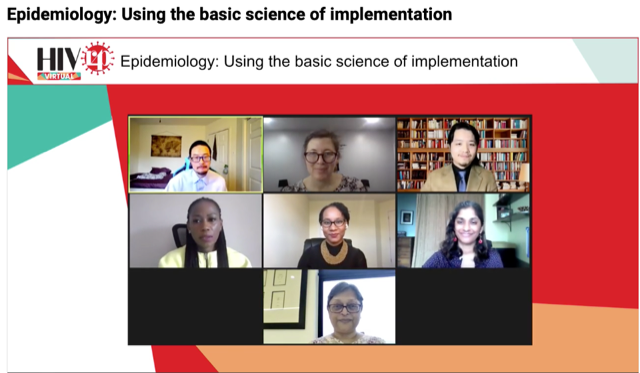HIV R4P Virtual: HIV prevalence and incidence among female sex workers participating in a phase IIB HIV vaccine preparedness study in Dar es Salaam,Tanzania
Diana Faini & Frank Msafiri, MUHAS
Diana Faini is a medical doctor and a trained epidemiologist based at Muhimbili University of Health and Allied Sciences, Tanzania since 2015. She has a keen interest in HIV research in both prevention and treatment interventions. She is currently a PhD fellow in Public Health at the Karolinska Institutet, Sweden. Her PhD work explores HIV risk, sexual and reproductive health among female sex workers in Dar es Salaam.
In the PrEPVacc trial at the MUHAS site, Diana coordinates recruitment, enrolment, and follow-up of study participants in collaboration with the study clinical team. She also develops and reviews communications materials for the PrEPVacc project engaging stakeholders within the country.
Frank Msafiri is a clinical microbiologist at Muhimbili University of Health and Allied Sciences. He has a major interest in the use of vaccines to prevent infectious diseases of public health importance. Frank is currently a PhD student at Karolinska Institutet, where he studies the humoral and cellular immune responses induced by candidate HIV vaccines in Tanzania and Mozambique.
In the PrEPVacc trial at the MUHAS site, Frank is responsible for laboratory investigations of participants’ samples including testing of HIV and hepatitis infections, measuring of CD4+ T cells and viral loads, and screening for other sexually transmitted infections. Furthermore, he is involved in providing information to the study participants about laboratory procedures in the PrEPVacc trial.
Diana and Frank’s paper was presented orally on 27 January (Diana pictured centre) at the conference HIV R4P Virtual, taking place between 27 January and 5 February 2021.
Below Diana and Frank share a Q&A on the key findings of their research, which is based on the PrEPVacc study:
What are the main messages of your presentation?
The PrEPVacc registration cohort study in Dar es Salaam was able to demonstrate that it is possible to identify, enrol and follow up female sex workers at high risk of HIV infection. We found that participants in our cohort had a high HIV incidence rate (3.5/100 person-years at risk), low pregnancy rate (7% within 12 months follow up) and high retention (80% at 12 months). We have demonstrated that it is feasible to conduct HIV prevention studies among female sex workers living in Dar es Salaam. This is an important step for site preparedness in anticipation of the PrEPVacc clinical trial.
What evidence did you gather and what insights have you drawn from it?
The HIV incidence in the PrEPVacc Registration cohort in Dar-es-Salaam in a 12 months duration was high with a rate of 3.5 per 100 person-years at risk (95%CI 2.3-5.3/100 person-years at risk). At the baseline screening, the prevalence of HIV, Syphilis, Hepatitis B and C virus infections were 8%, 1%, 2% and 1% respectively indicating that these infections are still of public health concern in this population.
The results demonstrate that female sex workers in Dar-es-Salaam are indeed a high HIV risk population and a suitable study population for future HIV prevention including HIV vaccine efficacy trials.
We found that young age, low education levels and being separated or widowed or divorced were strongly associated with the prevalence of HIV infections at baseline screening. Similar trends were observed for the incidence of HIV infections that we saw during the course of our study follow-ups, but the study wasn’t statistically powered to confirm this association.
Was there anything surprising about this?
At baseline screening, we found that 59 out of 775 of the female sex workers we recruited were HIV infected, giving an HIV prevalence of about 8%. However, this prevalence was lower than the 15% estimated from a survey among female sex workers in Dar es Salaam (Mizinduko et al 2020). We think this is because participants in our cohort had a lower median age compared to those in the survey and HIV prevalence is normally higher among older sex workers.
We had purposefully recruited younger female sex workers since HIV incidence – those infections arising over the course of the study - is normally higher among the young sex workers because they have less skill in negotiating condom use. A high HIV incidence is what makes a population suitable for an HIV vaccine trial.
What will you do next following this research?
These results will be published in a scientific journal and also disseminated locally to stakeholders including the Tanzanian Ministry of Health. We hope that the high HIV incidence reported will show the continued vulnerability of female sex workers and that they contribute to sustaining the HIV epidemic in the country. We hope the results will also spur efforts by the Ministry of Health to roll out PrEP to this community so as to minimize their HIV risk.
Is there anyone you’d like to thank in relation to this work?
We thank the study participants who agreed to take part in this study. We also thank the study research team for their dedicated efforts in data collection and maintaining the study cohort.

